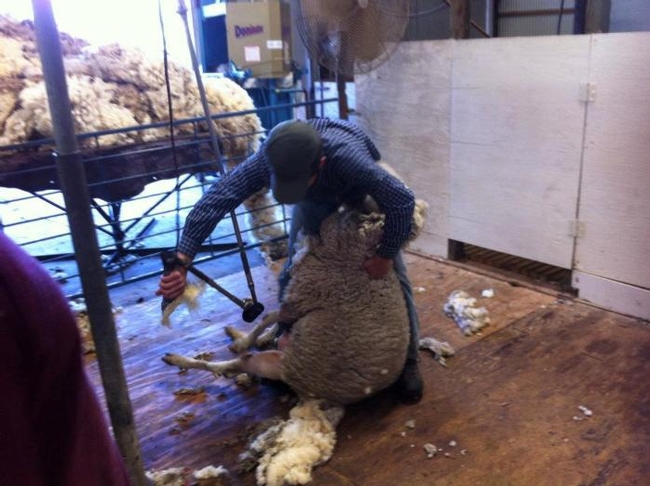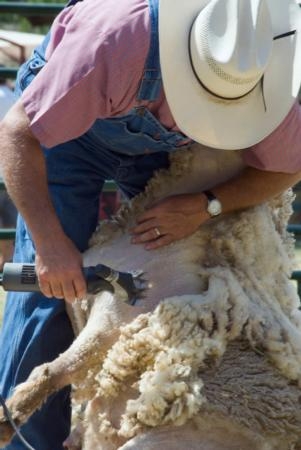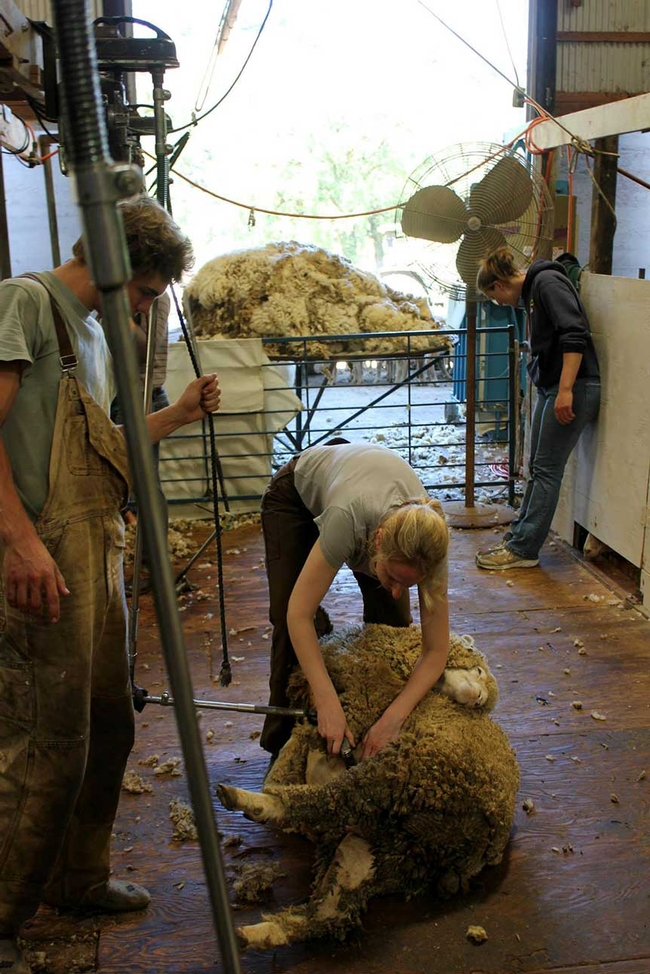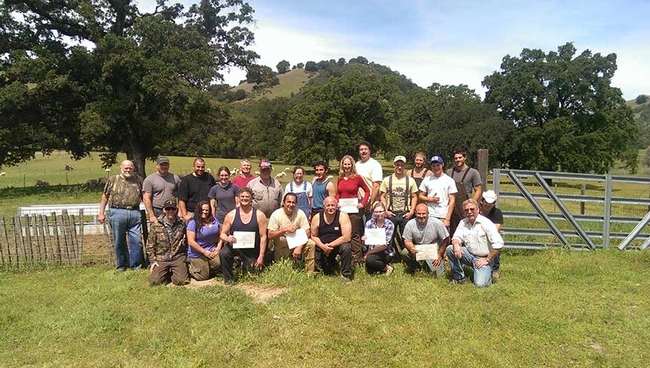Posts Tagged: Shearing
'Wild and wooly' sheep shearing class held at Hopland
Many sheep shearing students said the process was "the hardest thing they have ever done," reported Glenda Anderson in the Santa Rosa Press Democrat. The newspaper ran a lengthy feature and a photo gallery of the annual sheep shearing school held at the UC Hopland Research and Extension Center this week.
Reporter Justine Frederiksen of the Ukiah Daily Journal also reported on the sold-out sheep shearing and wool classing training at the 5,300-acre Mendocino County research center.
“And 60 percent of these people had never even touched a sheep before,” said John Harper, UCCE advisor and shearing school leader. Nearly all the students were women and included an artist from San Francisco, a retired fire chief, a UC Davis graduate student, and a woman who was learning to shear ahead of travels to New Zealand “because I think it will be a good skill to have for work, in case I want to stay for a couple of months.”
“One of the things new students have the most trouble with is what we call ‘tipping' the sheep, or flipping them over,” Harper said. He explained that, to get the sheep into the ideal starting position, you need to push its back legs down with one hand and tuck its head in with the other, twisting the animal into a sitting position with all four legs dangling.
UC Hopland REC sheep shearing students are part of a new wave of sheep shearers and wool enthusiasts industry officials hope will reverse decades of disinterest and decline. The shearing classes were booked well ahead of time, said Hannah Bird, a community educator at the research station. Many students are seeking a break from city life or jobs tying them to a desk.
Wrote reporter Glenda Anderson, shearing sheep is sweaty, back-straining work that earns just $2 to $5 per sheep. But an expert sheep shearer taking part in the program said sheep shearing for a living has its benefits.
“It's a lifestyle thing. I could work six months a year and travel around the world,” paying for the travel by working here and there, he said.
Software developer quits job to shear sheep
"This year, I was on a ranch almost every weekend from January through June," Wilke said. "I got pretty burnt out."
With skills honed in three five-day sessions of training at the UC Agriculture and Natural Resources facility in Hopland, she has found she can earn between $50 and $100 per hour shearing sheep.
John Harper, UC ANR Cooperative Extension advisor in Mendocino County, has hosted the sheep shearing school for 20 years and has 40 years experience with sheep shearing.
"It is the longest running shearing school in California and I believe it's currently the only one," Harper said.
The training school started with instructors imported from New Zealand. When the cost of travel became prohibitive, Harper brought in Mike McWilliams from Oregon. Later Gary Vorderbruggen, who trained under McWilliams, became the chief instructor.
The five-day course will be offered again in 2016 with classroom instruction, demonstrations and hands-on experience. Beginning and experienced shearers have the opportunity for one-on-one training. Class dates have not yet been decided. Registration information will be posted on the Sheep Shearing School webpage.
View a PDF version of the Sheep Magazine article by clicking the link below.
Sheep Magazine article
UC ANR workshop inspires economic development
UC Agriculture and Natural Resources (UC ANR) is helping get a new industry off the ground in Mendocino County, reported Justine Frederiksen in the Ukiah Daily Journal.
The UC Hopland Research and Extension Center, a UC ANR facility, hosts an annual Sheep Shearing School, thought to be the only one in California. The students take a five-day hands-on course to learn how to maintain a quality wool clip and minimize stress to the sheep.
"It's like learning to square dance," said instructor Gary Vorderbruggen. "Except you're learning to dance with an unwilling partner."
UC ANR Cooperative Extension natural resources advisor John Harper facilitates the school in Mendocino County.
"I always say, you'll never be unemployed if you learn how to shear," Harper said. "There's never enough shearers."
One local resident who attended Sheep Shearing School twice, Matthew Gilbert, was inspired to open a local wool processing enterprise.
"It's the perfect fit for this county, because it will provide jobs for this rural economy," Harper said.
Many wineries are using sheep to clip cover crops because the sheep can't get up on their hind legs like goats to reach the foliage. Even as more sheep are working local vineyards, "we're losing the infrastructure to support the (sheep) industry," Harper said.
Last week, the Ukiah Planning Commission unanimously approved permits for Gilbert to operate a wool mill and food truck on his property, said another article in the Ukiah Daily Journal. The food truck will help supplement the family's income for the first couple of years until the mill becomes established.
Further enhancing local interest in the Mendocino County sheep industry, the Hopland REC hosts a Barn to Yarn event from 10 a.m. to 2 p.m. May 23. Visitors will see shearing, spinning and weaving demonstrations and learn how to class wool and dye it using Kool-Aid. Admission is $5 per person, and children under 12 are free. The Hopland REC is at 4070 University Rd., Hopland. For more information, call Hannah Bird at (707) 744-1424, ext. 105.
Mozilla information scientist finds her passion at UC Sheep Shearing School
It's May in Hopland, and the sparse winter rains are nothing more than a memory. Sharpened shears at the ready, Stephany Wilkes, an information science Ph.D. who works for Mozilla, walks a 150-pound sheep into the shearing area. Under the watchful eye of expert instructors, she flips the sheep on its side and starts methodically removing the fleece, smoothing the skin with her left hand, clippers in her right, moving the sheep with her legs.
“It's like a dance,” she says. “Once you have it right (and I mean, really have it), suddenly the whole method makes sense. You expend much less energy. You're controlling the sheep with your legs, which leaves your hands free, one to hold the shearing hand piece and the other to smooth out the skin so you don't nick the sheep.”
Since there are 400 ewes whose fleeces must be shorn before the hot summer months, that's important for her and her classmates.
The University of California Cooperative Extension Sheep Shearing School is the only program of its kind in California. It has been run in Mendocino County since at least 1990, but in 2009, it moved to the Hopland Research and Extension Center south of Ukiah.
Students are taught the New Zealand method of shearing, where the entire fleece is cut from the sheep as a single unit so it can be sorted and graded according to micron count. The method is designed to be comfortable for both shearer and sheep.
John Harper, UCCE natural resources advisor for Mendocino County, has been running this program for more than 20 years. Although these sheep weigh enough to make handling them a workout, he says that hip flexibility is more important than upper body strength. Since this is something women tend to have more of than men, they are often successful students.
More than 250 students from across the western U.S. as well as Canada and Mexico and have graduated from the program. Many come back year after year to practice under supervision, but also to connect with each other.
This year, a wool grading section was added to the course, taught by Ron Cole and Rodney Kott. Sheep have recently been bred much more for meat than wool in the region but there is a growing demand for high quality fleeces. The finest merino sheep do not do well in damp North Coast conditions but thrive in the dryer Central Valley and foothills, and there is a need for trained graders. Only 3 percent of California's 5 million pounds of wool is currently being processed within the state, and yet California remains a net importer of wool goods, while falling second only to Texas in sheep production. California fleeces are either composted or sent to China for processing, something another graduate of Shearing Class, Matt Gilbert, is keen to avoid.
“There used to be lots of mills in the U.S. to process our wool,” he said. “Now there are hardly any. That's why I wanted to start my own mill to process fine wool. We will be selling to handspinners and knitters and to commercial textile manufacturers. It's about trying to keep the product of this place in the region.”
Gilbert was inspired by the Fibershed movement started by Rebecca Burgess in 2010. Drawing on the locavore movement, Burgess committed to clothing herself for an entire year with textiles grown and produced within 200 miles of her house in Fairfax. The movement is gaining adherents across the country and beyond.
Wilkes says the Fibershed movement is what got her interested in learning to shear, too.
“Eight years ago, I walked into a yarn store in San Francisco and asked where the local yarn was. I knew California was a major producer of wool. I was told there wasn't any. I was curious about why, and became involved with Fibershed and attended their first symposium in October 2012. During a panel involving shearers [one of whom was Matt Gilbert], I found out that small flock owners had a hard time finding people to shear their sheep. That got me thinking that I could learn to do the work," Wilkes said.
The UC certificate really means something to ranchers and farmers. As a woman who provided a Shearing School scholarship put it recently, “When I see UC Certification, I know I'm not going to have butchered animals.”
Harper explains that the North Coast sheep herding trends have changed over time – from large producers to smaller flocks – but now there is a move back to some larger flocks, driven in part by the Vines and Ovines project established in Mendocino County by UCCE advisor Morgan Doran with help from UCCE advisor Roger Ingram of Placer and Nevada counties, UCCE advisor Stephanie Larson of Sonoma County and UCCE specialist emeritus Mel George. The sheep were subjected to aversion training so they would not eat grape leaves. Now they browse through vineyards, conducting weed control and fertilization without harming the vines. One vintner, Clay Shannon, has 1,500 ewes. He pairs premium lamb with his wines in sales to niche markets. The idea is catching on.
Meanwhile, Wilkes is shearing sheep across Northern California on weekends or before work.
“I can't express how much Shearing School means to me and to California,” she says. “There's almost no way to break into agriculture if you didn't inherit land here. I found my calling late ... I love developing open source software and working on information privacy, but shearing is my passion. Shearing School is one of the few feasible avenues into agriculture in the state.”
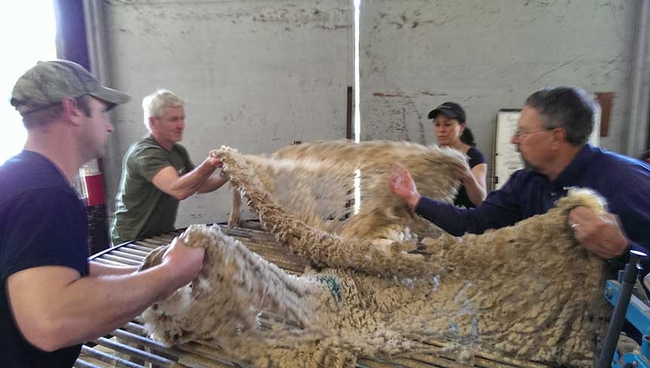
Wool classing.

Stephany Wilkes at the Sonoma County Fair.



